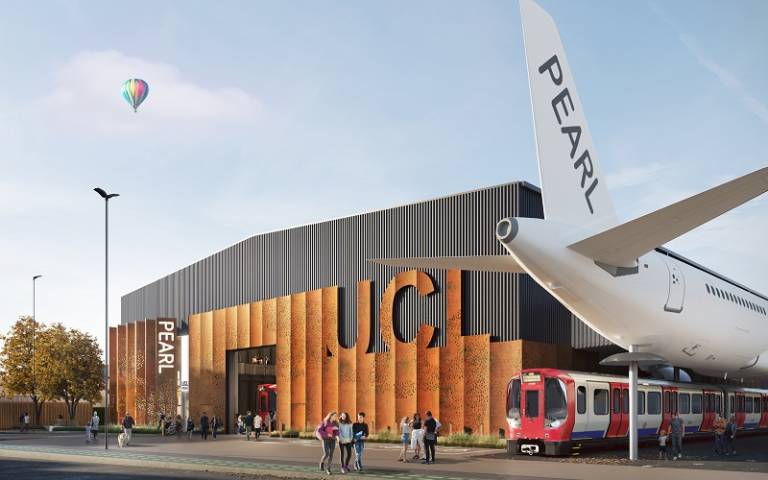PEARL is the first UCL building classified as net zero carbon
26 May 2021
UCL’s PEARL building in Dagenham, east London, has received an A+ rating for energy performance, making it UCL’s first net zero carbon building, with the export of surplus energy from solar panels expected to make it carbon negative.

According to the Energy Performance Certificate (EPC), which categorises buildings from A+ to G, newly built similar properties are most likely to be rated as 34|B, while typical older buildings usually achieve a 90|D rating or worse.
PEARL’s (Person-Environment-Activity Research Laboratory) CO2 rating of -9|A is due to strong levels of thermal performance, efficient mechanical and electrical systems and UCL’s largest installation of photovoltaic solar panels covering the entire roof.
The construction project – which completed in April 2020 – also incorporated a wide range of additional sustainability features, covering health and wellbeing, water efficiency and ecological management. There was a keen focus on low-impact, responsibly sourced construction materials and waste minimisation as part of a ‘circular economy’ approach to building design. The building is also expected to achieve a BREEAM Excellent rating for overall environmental performance.
PEARL’s Director, Professor Nick Tyler (UCL Civil, Environmental & Geomatic Engineering), said: "We all have a responsibility to take action on climate change. With PEARL we had a chance to make choices that could really make a difference, so the design of the building and its operations had to enable us to do all our research and education activities and to do this in a way that is beneficial to the environment.
“We are very proud that this has led to UCL's first carbon negative building. Achieving net zero and A+ for energy efficiency is great for the planet and pretty cool for UCL. Having this at the heart of all our decision-making from the outset has enabled this outcome."
Commenting on PEARL's completion, Neil Turvey, UCL Estates Development Assistant Director, said: “This has been an exceptional project from the outset with a clear academic vision. By working and performing as a team from concept to construction, we have been able to deliver this exceptional facility safely, on time and to budget. PEARL will now enable research into accessibility and mobility whilst providing UCL with its first carbon neutral in use facility, adding to the portfolio of Estates Development projects delivered achieving outstanding sustainability credentials . A great achievement by all those involved.”
Professor Nigel Titchener-Hooker, Dean of the UCL Faculty of Engineering, said: “This certification reflects the hard work invested by the team behind PEARL. Reducing our emissions and impact on the environment is important for the faculty and institution and I’m delighted that we are leading the way in offsetting emissions.”
The PEARL facility is designed to explore how people interact with their environment. It is around 4,000m squared and 10m high, allowing plenty of experimental space to create life-sized, controlled condition environments including a railway station, high street or town square, where people’s interaction with the environment and each other can be examined.
The facility will also allow researchers to study interactions at a micro-scale, such as brain activity, skin response, mass distribution in the foot or emotional responses. They will also study the physical displacements of people in response to environmental design (what they see, touch, hear, smell or feel) or to dynamic conditions such as explosions, instructions or external movements.
Professor Titchener-Hooker continued: “Following on from the early success of PEARL, we are now looking at how we emerge into a Covid-endemic world to work and relax safely.
“We are planning to create the world’s first Controlled Air Ventilation Environment (CAVE), which will work adjacent to PEARL. It will allow scientists and engineers to understand how airborne particles – including viruses and pollution – move around transport systems and buildings from airports to theatres, enabling better designs that improve our health and well-being.”
It is hoped that CAVE will boost efforts across a broad spectrum of challenges including how to ensure the UK is prepared for future virus outbreaks and demonstrate best practice, and tackle high indoor air pollution levels in cities, which is of increasing concern in an urbanised society.
Links
- PEARL
- Professor Nick Tyler’s academic profile
- Professor Nigel Titchener-Hooker’s academic profile
- UCL Centre for Transport Studies
- UCL Department for Civil, Environmental & Geomatic Engineering
- UCL Engineering
Image
- Credit: Penoyre & Prasad
Media contact
Kate Corry
Tel: +44 (0)20 3108 6995
Email: k.corry [at] ucl.ac.uk
 Close
Close

